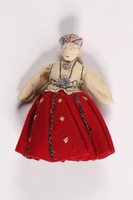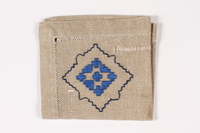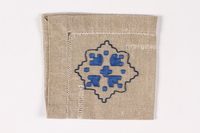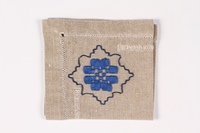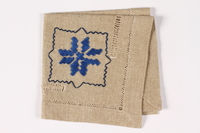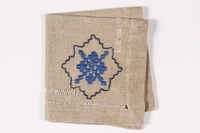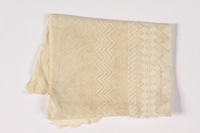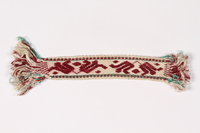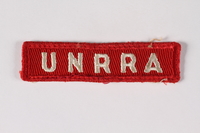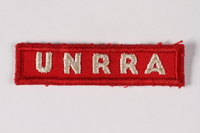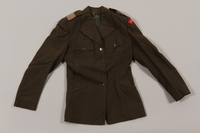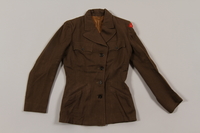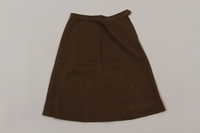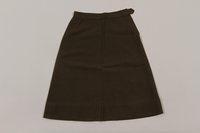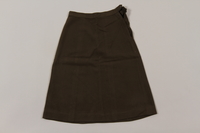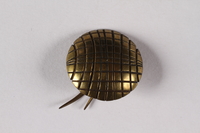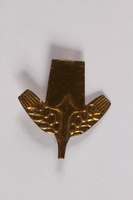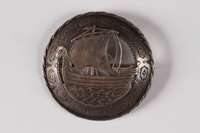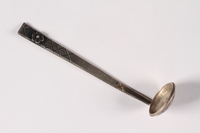Overview
- Brief Narrative
- Pewter teapot acquired by Dorothy Jones while working as an UNRRA Welfare Officer in the US zone of occupation in postwar Germany from July 1, 1945 - September 1948. It is part of a set, with the creamer, 2015.451.45. The origin is unknown but it was possibly gifted or purchased by her at a displaced persons market.
- Credit Line
- United States Holocaust Memorial Museum Collection, Gift of Barbara, C. Richard, and G. Robert Miller, in loving memory of their mother Dorothy Jones Miller
- Markings
- unmarked
- Contributor
-
Subject:
United Nations Relief and Rehabilitation Administration (UNRRA)
- Biography
-
The United Nations Relief and Rehabilitation Administration (UNRRA) was an international relief agency representing 44 nations, but largely dominated by the United States. Founded in 1943, it became part of the United Nations (UN) in 1945, and it largely shut down operations in 1947. Its purpose was to "plan, co-ordinate, administer or arrange for the administration of measures for the relief of victims of war in any area under the control of any of the United Nations through the provision of food, fuel, clothing, shelter and other basic necessities, medical and other essential services." Its staff of civil servants included 12,000 people, with headquarters in New York. Funding came from many nations, and totaled $3.7 billion, of which the United States contributed $2.7 billion; Britain $625 million and Canada $139 million. The Administration of UNRRA at the peak of operations in mid-1946 included five types of offices and missions with a staff totaling nearly 25,000: The Headquarters Office in Washington, The European Regional Office (London), the 29 servicing offices and missions (2 area offices in Cairo and Sydney; 10 liaison offices and missions in Belgium, Denmark, France, Italy, Luxembourg, the Netherlands, Norway, Sweden, Switzerland, Trieste; 12 procurement offices in Argentina, Brazil, Chile and later Peru, Cuba, India, Mexico, South Africa, Southern Rhodesia, Turkey, Uruguay, Venezuela; 6 offices for procurement of surplus military supplies in Caserta and later Rome, Honolulu, Manila, New Delhi, Paris, Shanghai), the sixteen missions to receiving countries (Albania, Austria, Byelorussia, China, Czechoslovakia, the Dodecanese Islands, Ethiopia, Finland, Greece, Hungary, Italy, Korea, the Philippines, Poland, Ukraine, Yugoslavia), and the Displaced Persons Operations in Germany.
UNRRA cooperated closely with dozens of volunteer charitable organizations, who sent hundreds of their own agencies to work alongside UNRRA. In operation only three years, the agency distributed about $4 billion worth of goods, food, medicine, tools, and farm implements at a time of severe global shortages and worldwide transportation difficulties. The recipient nations had been especially hard hit by starvation, dislocation, and political chaos. It played a major role in helping Displaced Persons return to their home countries in Europe in 1945-46. Its UN functions were transferred to several UN agencies, including the International Refugee Organization and the World Health Organization. As an American relief agency, it was largely replaced by the Marshall Plan, which began operations in 1948. [Source: UN Original finding aid of records of the United Nations Relief and Rehabilitation Administration (UNRRA)]
Physical Details
- Classification
-
Household Utensils
- Category
-
Tableware
- Object Type
-
Teapots (lcsh)
- Physical Description
- Pewter teapot with curved handle and spout and an ornamental hinged lid. The base has dhered felt rests
- Dimensions
- overall: Height: 8.000 inches (20.32 cm) | Width: 8.000 inches (20.32 cm)
- Materials
- overall : pewter, felt
Rights & Restrictions
- Conditions on Access
- No restrictions on access
Administrative Notes
- Legal Status
- Permanent Collection
- Provenance
- The teapot was donated to the United States Holocaust Memorial Museum in 2015 by Barbara, C. Richard, and G. Robert Miller, the children of Dorothy Jones Miller.
- Record last modified:
- 2022-07-28 18:27:11
- This page:
- http://collections.ushmm.org/search/catalog/irn531811
Download & Licensing
In-Person Research
- By Appointment
- Request 21 Days in Advance of Visit
- Plan a Research Visit
- Request to See This Object
Contact Us
Also in Dorothy L. Jones Miller collection
The collection consists of documents relating to Dorothy Jones [donors' mother] (b. July 17, 1914) who on July 1, 1945 began to work as Assistant Welfare Officer of UNRRA in US zone in Germany and left in September 1948 as Chief Welfare Officer. The documents include different reports, passports, lists, correspondence, UNRRA publications, and others. Two UNRRA uniforms (2 jackets and 3 skirts), sweaters, dolls, UNRRA patches, name bracelet, metal pins, dolls, doilies, other woven and embroidered items, wooden boxes, pewter set, silver pins and spoon - gifted to Ms. Jones or purchased by her at DP market; Drawings and caricatures; two photo albums founds by Ms. Jones in the building where UNRRA was housed - the albums belonged to German officers and date 1940 and 1941. Oil painting by Nora Drapche, a DP from Latvia, of a washer woman. Blouse, poster, photographs, correspondence, ration card, Christmas cards.
Date: 1940-1948

Doll in traditional Polish costume
Object
Cloth doll in traditional Polish clothing, made for a present in Christmas 1945, by a Polish man just out of the concentration camps.
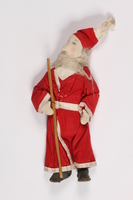
Father Christmas doll
Object
Father Christmas doll dressed in a red suit made from a Nazi flag. The doll used to have a walking stick and a small bag of gifts. Father Christmas was the bringer of gifts to the children in Latvia, Lithuania, and Estonia. This doll was made in 1945 in Mitterteich, Germany
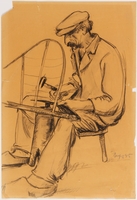
Drawing
Object
Charcoal sketch of a man making a piece of furniture, by Margarita Stepnieks, a Lithuanian displaced person living in Wurzburg.
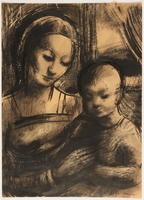
Drawing of Madonna and Child
Object
Ink and watercolor drawing depicting Madonna and Child, by Margarita Stepnieks, a Lithuanian displaced person living in Wurzburg.
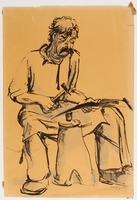
Drawing
Object
India ink sketch of a man making a piece of furniture, by Margarita Stepnieks, a Lithuanian displaced person living in Wurzburg. Sketch is dated 1945.
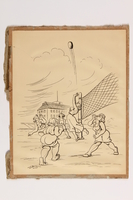
Caricature
Object
Depiction of women playing volleyball. One of three cartoons depicting sports in a DP camp in Wurzburg. The cartoons are by Mr. S. Bercs, a Latvian. Dated 1947
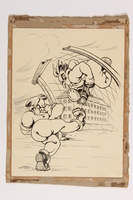
Caricature
Object
Depiction of men playing soccer. One of three cartoons depicting sports in a DP camp in Wurzburg. The cartoons are by Mr. S. Bercs, a Latvian. Dated 1947.
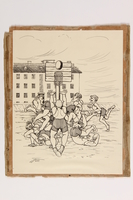
Caricature
Object
Depiction of a group of men playing basketball. Cartoon is dated 1947. One of three cartoons depicting sports in a DP camp in Wurzburg. The cartoons are by Mr. S. Bercs, a Latvian.
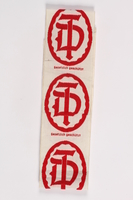
Strip of cloth labels
Object
Strip of repeating labels with the words "Gesetzlich geschutzt" and the letters T and D with a red oval border around them.

Tablecloth
Object
Tan linen tablecloth with a geometric pattern embroidered in blue thread. Forms a set together with the napkins

Armband with swastika
Object
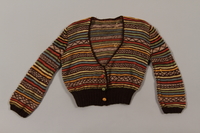
Sweater
Object
Buttoned cardigan with multicolored stripes. The sweater was knit for Ms. Jones in Germany by a Latvian woman in 1946. Ms Jones' mother sent her the wool from the United States.
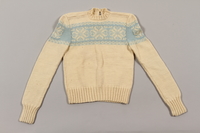
Sweater
Object
Sweater with a traditional Estonian snowflake design. It was acquired in Wurzburg, Germany.
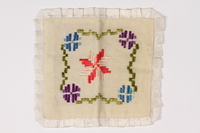
Embroidered doily
Object
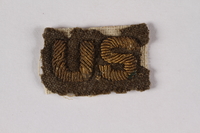
U.S. patch
Object
"U.S" embroidered in metallic thread on a cloth backing torn from an item of clothing
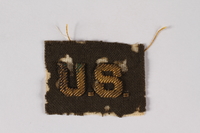
U.S. patch
Object
"U.S" embroidered in metallic thread on a cloth backing torn or cut from an item of clothing
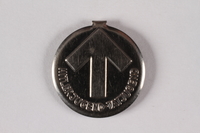
Hitler Youth clip
Object
Clip, probably made of tin, with an upward facing arrow and the words "Hitlerjugend-Tatjugend"
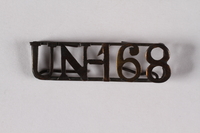
Pin
Object

Republic of Latvia pin
Object
Round silver colored pin with the central portion made out of a 1931 five Lati Latvian coin. The front of the coin (and pin) depicts a woman's profile and the words "Republika Latvijas."
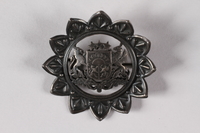
Pin with Latvian coat of arms
Object
Silver colored pin with coat of arms in the center and bordered with a floral design. The piece bearing the coat of arms is made from a 1925 two Lati coin
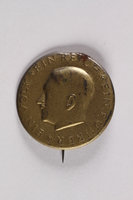
Pin
Object
Metal pin, probably tin, painted gold on the front with an image of Hitler in profile and the words "Ein Fuhrer Ein Volk Eine Reich" forming a border around the central image.
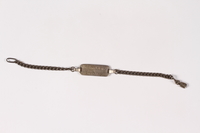
Identification bracelet
Object
identification bracelet belonging to Dorothy L. Jones and engraved with her name and "UNRRA." The bracelet was given to her upon her retirement.
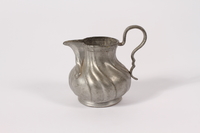
Pewter creamer acquired by an UNRRA aid worker
Object
Pewter creamer acquired by Dorothy Jones while working as an UNRRA Welfare Officer in the US zone of occupation in postwar Germany from July 1, 1945 - September 1948. It is part of a set, with the teapot, 2015.451.46. The origin is unknown but it was possibly gifted or purchased by her at a displaced persons market.

decorative wooden box
Object
Carved wood rectangular box with hinged lid, now detached. Made at Hersbruck, a Latvian DP camp.
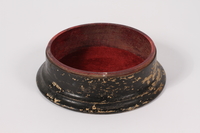
decorative wooden box
Object
Round box with detached lid engraved with geometric designs. The box was bought in Germany from a Ukrainian camp. According to the donor the design is typical of the Ukraine but they could not get good wood or good paint for this box.

decorative wooden box
Object
Rectangular wood box with hinged lid (now detached). Lid is carved and painted with images of three ladies in traditional dress

Oil painting of a washerwoman
Object
Oil painting by Nora Drapache, a DP from Latvia, depicting a washerwoman.
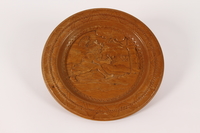
Wooden plate picturing a girl chasing butterflies made in a displaced persons camp
Object
Wooden plate with a carving of a girl chasing butterflies made by Nord Kaserne in the Latvian displaced persons camp in Wurzburg, Germany, in 1948. Nord was a carving teacher at the DP camp, and a pupil at the University of Riga of Nora Drapsche. His painting, Washer woman, is also part of this colllection.
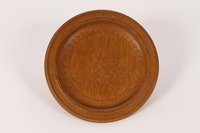
Wooden plate with a carving of a man and a horse made in a DP camp
Object
Wooden plate with a carving of a man and a horse made by Nord Kaserne in the Latvian displaced persons camp in Wurzburg, Germany, in 1948. Nord was a carving teacher at the DP camp, and a pupil at the University of Riga of Nora Drapsche. His painting, Washer woman, is also part of this colllection.
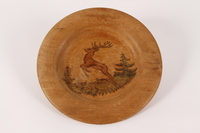
Decorative painted wooden plate
Object
Wooden plate with the painted image of a stag in a forest setting. The plate was bought in Germany between 1945 and 1948 by Skip Miller.
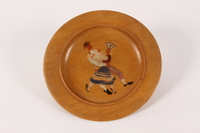
Decorative painted wooden plate
Object
Wooden plate with the painted image of a male and female dancer in traditional Estonian dress. The plate was bought in Germany in 1946.
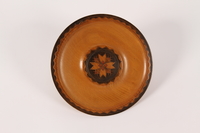
Decorative wooden plate with paint and inlay
Object
Wooden plate accented with paint and metal inlay. Acquired at the Lithuanian DP camp in Wurzburg's "Art Show" in 1948. The plate was made by E. Liepins, whose name is carved into the back of the plate.
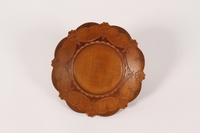
Wooden plate with a carved floral rim made in a displaced persons camp
Object
Wooden plate with a carved floral rim made by Nord Kaserne in the Latvian displaced persons camp in Wurzburg, Germany, in 1948. Nord was a carving teacher at the DP camp, and a pupil at the University of Riga of Nora Drapsche. His paintng, Washer woman, is also part of this colllection.
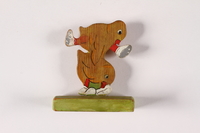
Painted wood figurine made in a displaced persons camp
Object
Small painted wood figurine depicting one chick jumping over another. The figurine is on a wood stand which is signed on the bottom by several different individuals.
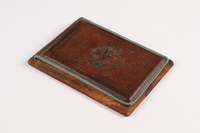
Leather notepad case
Object
Leather and suede notepad case with an inscription inside engraved on silver. The inscription reads, "To: Miss Dorothy Jones, Area Welfare Officer, A token of appreciation and personal regard. From: Care & Maintenence Dept, JRO Area 3, Wurzburg, Germany, Sept/48."
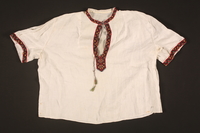
White blouse with embroidery
Object
White short-sleeved woven blouse with multicolored pattern embroidered along sleeves and neckline. Also has tie at neck with tassels.
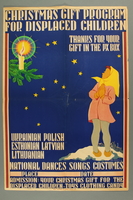
Poster advertising Christmas gifts for displaced children
Object
Poster advertising Christmas gift program for displaced children from the Ukraine and from Poland, Estonia, Latvia and Lithuania.
Dorothy L. Jones Miller papers
Document
Contains documents, reports, passports, correspondence, publications, and photo albums relating to Dorothy Jones [donors' mother], who was an Assistant Welfare Office with the United Nations Relief and Rehabilitation Administration (UNRRA) in the United States Zone of occupied Germany from July 1, 1945 until September 1948, when she left as a Chief Welfare Officer. Includes two photo albums found by Jones in the building where UNRRA was housed; the albums had belonged to German officers and were dated 1940 and 1941.

